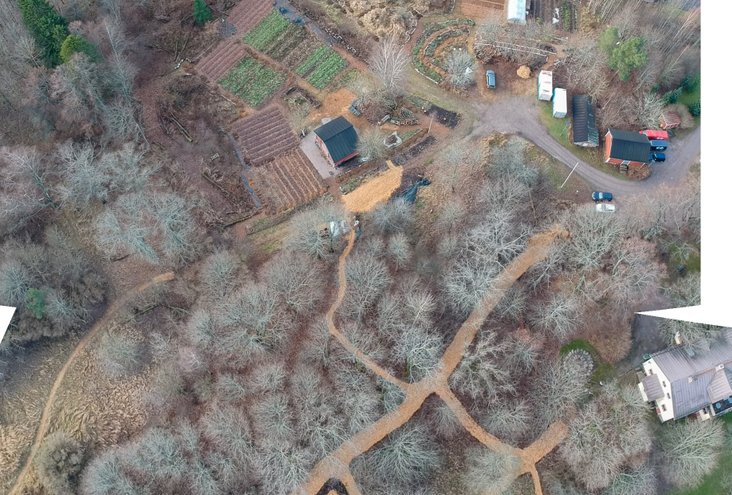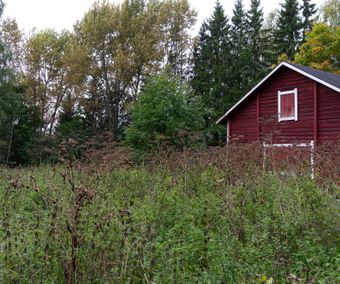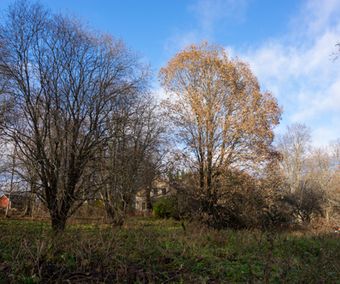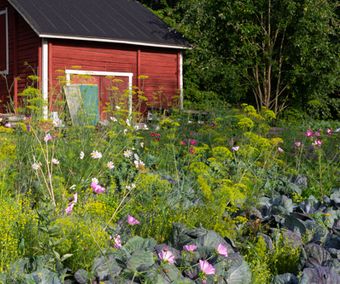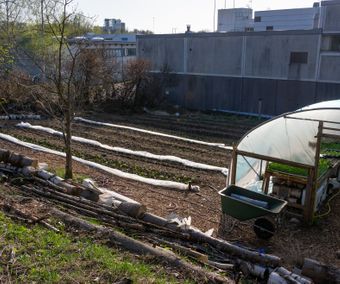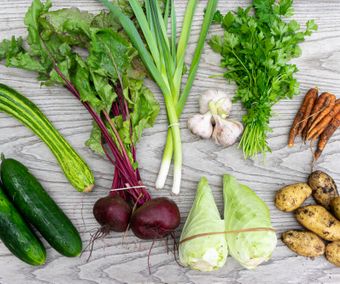THE FIELD STUDIO AT
LILLKLOBB
August 2016 - December 2021
As one of the first farms in Finland to be designed with agroecological principles from the start, Lillklobb was a place of exploration as much as production.
Lillklobb featured a dual-use general plan. Divided roughly into halves, one side of the site demonstrated profitable means of applying nature's patterns to commercial-scale primary production while the other focused on public-good oriented design and domestic-scale activities.
My time at Lillklobb was increasingly oriented towards pushing the boundaries of small scale regenerative practices.
I visited Lillklobb for the first time in late 2015 and began my contract there at the end of August 2016. From late 2016 until 2021, I developed the site full time from a place that lacked even one single garden or any infrastructure into a small scale regenerative farm capable of providing over fifty families with weekly vegetables during our growing season on less than 1000m2 of permanent bed space.
The project ended in 2021.
2016-2020: Lillklobb Permaculture
I launched my work to revitalize the landscape at Lillklobb back in late August 2016. It was to be my first attempt at starting a farm from scratch. With a shoestring budget and the time afforded to me by Finland's "start up grant"- which covers basic income needs of a new entrepreneur- I was able to gain a foothold.
At first I implemented way too many of my own ideas and tried to do too much at once. After one season of that I knew I should go back to basics and copy as close as possible the patterns laid out by successful market gardeners.
I was able to slowly but surely eliminate the weed pressure and build up soil fertility by following in the footsteps of others. I am forever grateful to the many interns who then followed in mine for each growing season. Without their help and dedication the gardens would not be nearly as abundant ans they became.
Over the years I continually updated my sales model to account for lessons learned and the little market garden at Lillklobb has managed to serve customers from our local neighborhood through to diners at some of Helsinki's most prestigous restaurants. Some vegetables have even wound up in the kitchens of embassies in the capital.
All of that effort led to a situation where I was learning an incredible amount, but also growing dissatisfied with the amount of time primary production- as the main means of generating an income- required on a "commuter farm." My plans to develop the whole place into a demonstration site with multiple kinds of patterns at play were moving too slowly.
By late 2019 the work of myself and others in the field more broadly was becoming better known and a joint project with Unga Teatern and Learning in Nature Ltd was initiated: the Theater Forest Garden. Although the coronavirus has slowed down our work, this project may allow the site to receive the care and attention it deserves.
A Brief Look at Lillklobb's Transformation
2021: Finch Agroecology's
Field Studio
From the beginning I was never quite sure as to what to call my company and what I was doing. As the years went on, I understood that no one knew about Lillklobb, nor what the word "permaculture" meant. Therefore the name of my company was doubly meaningless to most people.
That's really not a good business strategy. At the same time, I was becoming aware that my prolonged efforts to set up the market gardens as the primary economic engine of my company were overshadowing the actual thing I was attempting to do: demonstrate different ways of interacting with nature to bring about positive outcomes for the whole.
Most people thought of me as "that vegetable guy" (who won't pack baby lettuce into a bag). They had no idea that the vegetable farm was just one part of a bigger picture.
I wasn't telling my story properly. I had been so driven to make things work that I failed to document my own farm as well as I had other projects in the past. A lot of the skills I had brought with me on this journey were falling by the wayside.
These were among the reasons I chose to change the name of my company in early 2021. Funnily enough, I had always named my company this in my private documents but it never felt right until now to make it public.
With this new name and stronger focus on education, the intention was that Lillklobb would continue in much the same manner as before. The key difference was the recognition that my actions were as much about my own motivations and interests as much as they were about bringing this once-underused place back to abundance. Lillklobb is an integral part of a greater whole.
Lillklobb was my Field Studio. This was where I was free to pursue what interests me and try to find novel patterns. Lillklobb was a living emodiment of my creativity, an ongoing trial. It is extremely important for me to actually live with and work on the systems I teach about.
All things change, however, and due to a variety of reasons, I decided to step back from Lillklobb in late summer 2021.
EARNING A LIVING WITH
COMMERCIAL PATTERNS
From 2017-2020, the majority of my income came through the sale of produce grown at Lillklobb. This is no small feat in one of the most expensive metropolitan regions on earth, especially when you stop to consider our climatic constraints, the size of the land at my disposal, my lack of resources, and immigrant status.
It may not have been much since I've had to reinvest most of the profits, but there is certainly a pathway to follow for people with an easier context.
Earning a living this way was always important to me because I wanted to show people that these methods can produce high quality products in enough quantity that they don't need to be sold for obscene amounts of money to be profitable.
At Lillklobb, I synthesized the teachings of a number of well known market gardeners and started to develop my own methodologies.
I have always trained a very critical eye on my own work. I see issues with the way market gardening presents itself to the world and the reality back on the farm.
I'm very interested in the issues of ghost acres, crop diversity, biological based soil fertility, and what it means to take responsibility for the ecosystem. I see a relative lack of attention to these issues within the broader market gardening sphere while noticing that folks practicing broad acre regenerative agriculture are seemingly light years ahead.
I want to explore the very limits of regenerative agriculture practices. I don't find copying others and hand waving away very real issues to be very motivating.
If you'd like to learn more about how I farmed at Lillklobb you can read more by following the green button below.
I will continue to develop these methods and practices on other farms I consult with.
THE
THEATER FOREST GARDEN PROJECT
Way more than a "food forest," the Theater Forest Garden aimed to provide the impetus for bringing the other half of Lillklobb to life by opening up ideas related to sustainability, citizen engagement, art, and marginal spaces through collaborative design
Since pitching the concept behind what was then Lillklobb Permaculture to the Culture Department of Espoo back in 2015, the eastern half of Lillklobb was slated for what I called "public oriented design." There were many reasons for this: upon completion of a thorough site analysis, almost all the signs pointed towards this area of the property not being conducive to the kinds of systems I would need to implement for a commercial farm. Rather than fight against the soil, light availability, and land-use expectations, it made much more sense to work with all of the above. "Public oriented design" means the same thing now as it did then: the systems should support their surroundings and provide a useful example to the public at large.
Development of the yard around the house and the old apple orchard was slow for a variety of reasons. Besides being planned as a secondary enterprise, working with places that are literally under the nose of other people requires a bit of consideration than just "doing it." As the commercial side found its stride in recent years, more attention could be turned to this area of the farm year over year. However, it was slow going given the reality of running a high turnover market garden.
My initial ideas were given a new lease on life after a staff member of Unga Teatern participated in the "Introduction to Children in Permaculture" course taught by Gaye Amus of Learning in Nature, Ltd- which I had invited her to host at Lillklobb. By means of a third party the connection between permaculture and theater clicked and soon Unga Teatern was writing an entirely new outdoor performance for their 60th Jubilee year and funding was applied for to weave the two together.
The coronavirus pandemic completely altered the project's timeline, but our dedication to designing a one-of-a-kind "Theater Forest Garden" continued. Fortunately, the Culture Department of Espoo was willing to donate wood chips and the Helsinki Region Environmental Services (HSY) donated "green waste" compost made here in Espoo to the project at cost. Besides a lot of labor, these two inputs are the main things one needs to protect and nourish the soil in order to prepare forest garden beds for planting.
The Theater Forest Garden project came to an end after the inital design phase.
WHAT IS A FOREST GARDEN?
A forest garden is simply a garden that mimics a forest: many different trees, bushes, and other kinds of plants growing together that can offer people beauty, purpose, and food through many years. Often in our climate these gardens will have wider spacings between trees to allow the understory to be more productive. Depending on your point of view, they may not actually be "forests" at all.
Still, by copying nature’s tendency to grow forests in Finland, we can work with natural forces and provide habitat to many kinds of plants, insects, birds, and mammals thereby increasing local biodiversity.
Forest gardens are an expression of “agroforestry”: the deliberate inclusion of trees and bushes in agricultural settings to (among other things) improve the local ecosystem, provide diverse yields, and combat both some of the causes and effects of climate change. A "food forest" is a type of forest garden. In much the same way we hope that a "theater forest garden" will also become its own subset with design patterns that can be replicated around the world.
